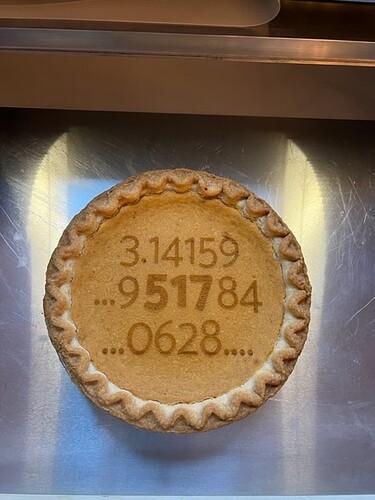Its Pi day! So I engraved a pie for work.
I figured it also might be a good time to do a post on my experience so far with lasers and food. But first thing to cover it policy.
Also, this post is not saying to just start engraving food and eating it. It is saying to be smart about it and what I choose to do when I engrave food.
FDA Policy 179.43 Carbon dioxide laser for etching food.
Carbon dioxide laser light may be safely used for etching information on the surface of food under the following conditions:
(a) The radiation source consists of a carbon dioxide laser designed to emit pulsed infrared radiation with a wavelength of 10.6 micrometers such that the maximum energy output of the laser does not exceed 9.8 × 10−3 joules per square centimeter (J/cm2);
(b) The carbon dioxide laser shall be used only for etching information on the skin of fresh, intact citrus fruit, providing the fruit has been adequately washed and waxed prior to laser etching, and the etched area is immediately rewaxed after treatment; and
(c) The maximum total energy to which the etched citrus fruit is exposed from the use of the carbon dioxide laser shall not exceed 1.5 × 10−3 J, and the maximum total etched surface area of the citrus fruit shall not exceed 0.122 cm2.
Full policy
So…unless you really just want to focus on fruit, you are already not meeting FDA policy. If you don’t care about meeting FDA policy then the next thing to look into is sanitation policy.
Sanitation
Food Contact Surfaces - “are those surfaces that contact human food and those surfaces from which drainage, or other transfer, onto the food or onto surfaces that contact the food ordinarily occurs during the normal course of operations. “Food-contact surfaces” includes utensils and food-contact surfaces of equipment.”
Search the link below for food contact surfaces and you will find a lot of useful information on that.
eCFR :: 21 CFR Part 117 -- Current Good Manufacturing Practice, Hazard Analysis, and Risk-Based Preventive Controls for Human Food
Now I have seen enough dirty GF pictures to know that there certainly are a lot of machines that would not meet all the standards for food contact surfaces. The safest method is to have a food only machine. However, it doesn’t mean your machine is fully disqualified if you put non food in it. It just is harder to keep your machine clean and within sanitation standards. Below is a list of things I do:
-
I have one machine that is fabric and food only.
-
I have a carriage plate that is food only (so the assist fan is clean) and I put on the food only carriage plate any time I engrave food.
-
I sanitize my GF bed before doing any food engraving .
-
I have an Air Quality Pollution Monitor to verify the circulation in my machine is safe before I engrave.
-
I also unplug my inline fan to cut down on circulation…but the inline fan is there for a reason so I wouldn’t get too comfortable with this.
So now onto food settings. I have put together a google slide deck with all my food settings so far. I will keep adding slides to it in the future whenever I engrave more food.
